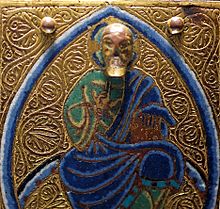


Vermiculation is a surface pattern of dense but irregular lines, so called from the Latin vermiculus meaning "little worm" because the shapes resemble worms, worm-casts, or worm tracks in mud or wet sand. The word may be used in a number of contexts for patterns that have little in common. The adjective vermiculated is more often used than the noun.
Vermiculation naturally occurs in patterns on a wide variety of species, for example in the feathers of certain birds, for which it may provide either camouflage[1] or decoration. Several species are named after this trait, either in English or by the Latin vermicularis.
It also appears in architecture as a form of rustication where the stone is cut with a pattern of wandering lines. In metalwork, vermiculation is used to form a type of background found in Romanesque enamels, especially on chasse reliquary caskets. In this case the term is used for what is in fact a dense pattern of regular ornament using plant forms and tendrils. In Ancient Roman mosaics, opus vermiculatum was the most detailed technique, and pieces are often described as "vermiculated" in English.
- ^ See, e.g., Iain Campbell, Sam Woods, Nick Leseberg, Birds of Australia: A Photographic Guide (2014), p. 110.